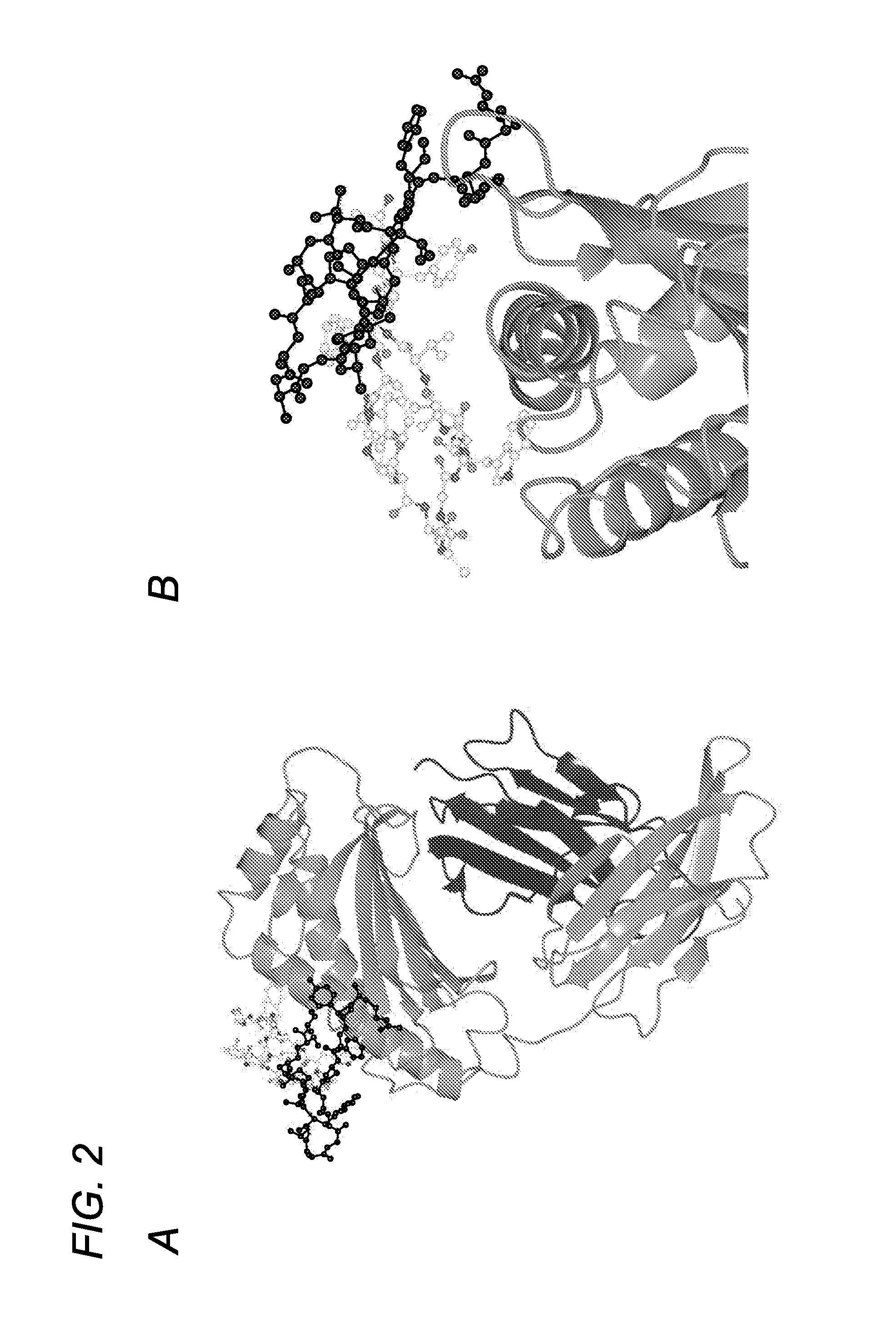FC receptor (FcRn) binding peptides and uses thereof
a technology of fc receptor and binding peptide, which is applied in the direction of peptides, peptides/protein ingredients, instruments, etc., can solve the problems of abnormally low levels of both ligands, and achieve the effects of reducing the pathologic level of albumin, inhibiting or blocking the interaction, and increasing the degradation of albumin
- Summary
- Abstract
- Description
- Claims
- Application Information
AI Technical Summary
Benefits of technology
Problems solved by technology
Method used
Image
Examples
example 1
[0374]Using phage display screening, we identified peptides capable of specifically blocking the interaction between FcRn and albumin as assessed by surface plasmon resonance (SPR) analyses. In order to do so, a peptide identified in the screen (SYN514 (Ac-AGVMHCFWDEEFKCDQGGTGGGK-CONH2) (SEQ ID NO: 4) which bound to a unique site (non-IgG, non-albumin competitive) on the FcRn alpha 3 domain as defined by X-ray crystallography was required and utilized in the screen for identifying specific albumin binding peptides. By this means, the peptide SYN571 uniquely bound to FcRn as defined by surface plasmon resonance as compared to peptides blocking the interaction of FcRn with IgG which did not block albumin and vice-versa (FIG. 1). Examination of the structure activity relationship identified a core sequence of the peptide binding to the novel epitope on FcRn and was called SYN1753 (Ac-RYFCTKWKHGWCEEVGT-CONH2 (disulfide), 17-MER (SEQ ID NO:1)) which had a binding affinity of approximatel...
example 2
Procedures Used in the Discovery of SYN-514 and SYN 571 Series of shFcRn-Binding Peptides
[0375]Selection procedures were adapted from Syntonix lab notebook 164. Routine procedures and most buffers were adapted from Syntonix or Dyax Corp. protocols.
example 3
Phage Display Selection to Identify SYN514, SYN515 and SYN531
[0376]Using phage display screening, the inventors identified peptides (“SYN514”, “SYN515” and “SYN531”, and their analogs) capable of binding to a non-IgG and non-albumin competitive site on a FCRN alpha 3 domain, which are useful for tracking neonatal Fc receptor FCRN without inhibiting IgG or albumin binding or function
[0377]Buffers and routine procedures were as described for the discovery of SYN571, except as described below. Round 1 of the selection process was also as described, and is repeated below.
[0378]Exemplary Selection Procedure: Round 1:
[0379]Approximately 100 random library equivalents were pooled according to their titers: 24 μl TN9-IV (1.3×1010 pfu / μl), 12.5 μl TN10-X (1.6×1010 pfu / μl), 225 μl TN11-I (1.2×109 pfu / μl), and 48.27 μl TN12-I (2.9×109 pfu / μl) were mixed with 190.2 μl PBS and 200 μl ice-cold 17% PEG (8000 Da molecular mass, Sigma)+3M NaCl, and incubated on ice for 30 minutes. The phage pool was...
PUM
| Property | Measurement | Unit |
|---|---|---|
| pH | aaaaa | aaaaa |
| molecular weights | aaaaa | aaaaa |
| molecular weights | aaaaa | aaaaa |
Abstract
Description
Claims
Application Information
 Login to View More
Login to View More - R&D
- Intellectual Property
- Life Sciences
- Materials
- Tech Scout
- Unparalleled Data Quality
- Higher Quality Content
- 60% Fewer Hallucinations
Browse by: Latest US Patents, China's latest patents, Technical Efficacy Thesaurus, Application Domain, Technology Topic, Popular Technical Reports.
© 2025 PatSnap. All rights reserved.Legal|Privacy policy|Modern Slavery Act Transparency Statement|Sitemap|About US| Contact US: help@patsnap.com



